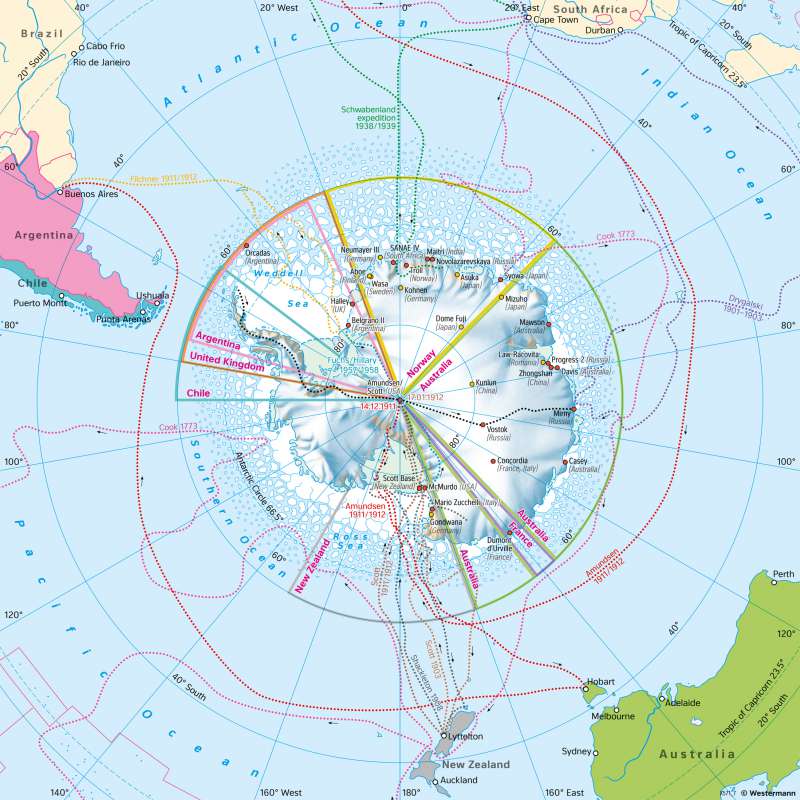Antarctic - Discoveries and territorial claims
Human activities and environmental change
978-3-14-100890-6 | Page 200 | Ill. 1

Overview
One of the first Europeans to reach Antarctica was James Cook. On his second voyage, he crossed the southern Arctic Circle and saw the ice-covered coasts but did not recognise them as the edges of a continent.
Research and disoveries in the Antarctic
Exploration for economic and scientific interests then began in the 19th century. The Englishman William Smith reached the South Shetland Islands in 1819, and Fabian Gottlieb von Bellingshausen, a Baltic German, first discovered land south of the Arctic Circle (to the west of the Antarctic Peninsula). The British navigator James Weddell advanced as far as the Weddell Sea in 1822/1823. Dumont d’Urville, a Frenchman, reached Adélieland in East Antarctica in 1840. James Clark Ross discovered South Victoria Land, the Ross Ice Shelf and the Ross Islands between 1839 and 1843.
The first German expedition, the "Gauss Expedition" (1901-1903) led by Erich von Drygalski, discovered Kaiser Wilhelm II Land, and, at the same time, the "Discovery Expedition" led by Robert F. Scott reached King Edward II Land. The Briton Ernest Shackleton came within 180 kilometres of the South Pole in 1909 but had to turn back there. The South Pole was first reached in the austral summer of 1911/1912 in a tragic race between the Norwegian Roald Amundsen and the Englishman Robert Scott. Scott, who arrived at the South Pole only four weeks after Amundsen, was killed with his companions on the way back. Almost at the same time, a German expedition under Wilhelm Filchner discovered the Luipold Coast (German: Prinzregent-Luitpold-Land) and the Filchner Ice Shelf. The third German Antarctic expedition in 1938/1939 under Alfred Ritscher discovered New Swabia (Neu-Schwabenland). Vivian Fuchs and Edmund Hillary managed the first Antarctic crossing from the Weddell Sea via the South Pole to the Ross Sea in 1957/58 on caterpillar snowmobiles. A different route was taken by the International Trans-Arctic Expedition in 1989/1990, which led from the Antarctic Peninsula via the South Pole to Mirny Station in the Australian sector.
Until today, numerous countries have set up research stations. The researchers from the Alfred Wegener Institute for Polar and Marine Research primarily use the year-round Neumayer III station. At the Kohnen summer station, located about 500 kilometres to the northeast, ice cores are obtained for research into climate history.
Territorial claims
Various countries lay claim to sovereignty over individual sectors of Antarctica. Among them are riparian states such as Chile, Argentina, and Australia, but also countries that derive their claims from early voyages of discovery and exploration (for example Norway) or from seizures of power in the 19th century (for example Great Britain). The only area not yet claimed by any state is Marie Byrd Land in the southwest.
In the Antarctic Treaty of 1959, twelve states agreed to defer their territorial claims in favour of internationally cooperative exploration of the continent while preserving its sensitive nature. To complement this treaty, the 1991 Madrid Antarctic Conference decided to ban all mining for 50 years. A corresponding law was signed by all 26 voting states in 1997 and came into force in 1998. Today, there are numerous research stations in Antarctica.




